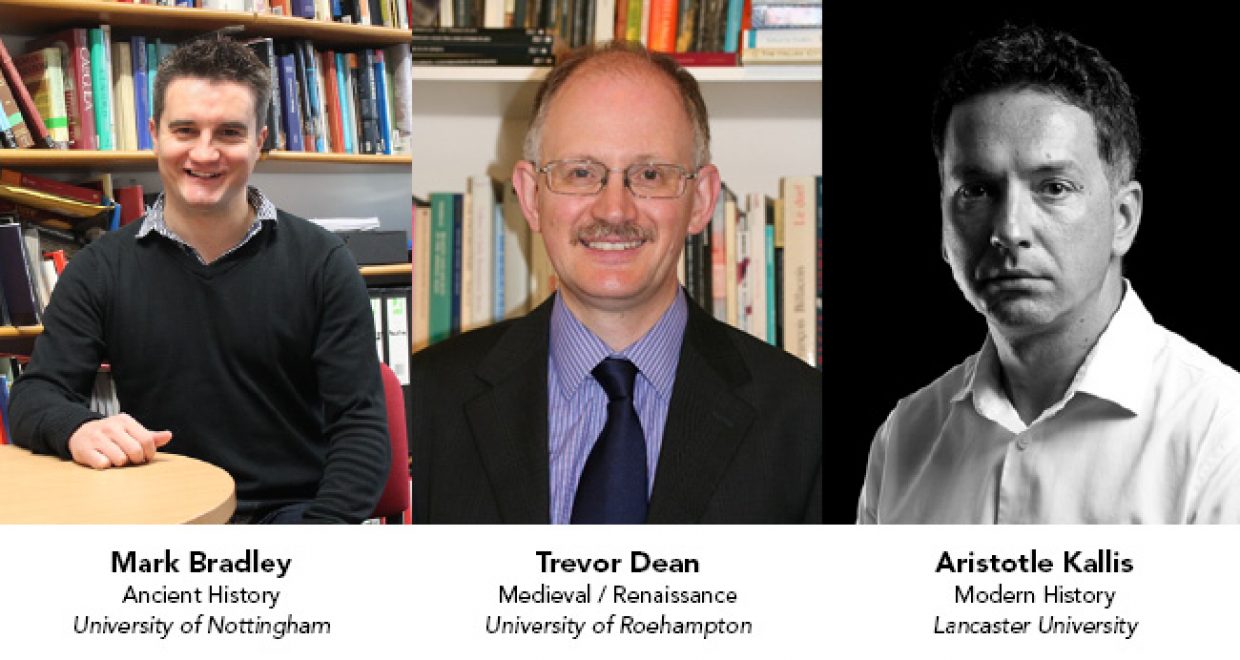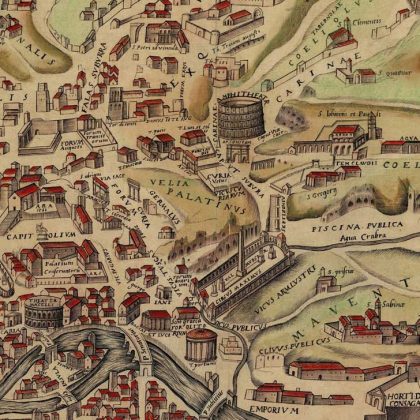Papers of the British School at Rome: Meet the Editors
Earlier this year, the British School at Rome’s Faculty of Archaeology, History and Letters decided to extend management of Papers of the British School at Rome (PBSR) from a single editor to a team of three editors in order to represent and promote the full disciplinary and chronological range of the journal. The three editors will continue to work closely with members of the Faculty, as well as staff and scholars of the BSR and Cambridge University Press, in order to publish high-quality peer-reviewed papers on the archaeology, literature and history of Italy and other parts of the Mediterranean on which Italy has exerted an influence. Below, the three editors introduce themselves and their interests and areas of expertise, and flag up some of their favourite PBSR papers in recent years, which have been made available to you free of charge. If you have an idea for an article that you would like to send to the journal, the editors would be happy to discuss it further with you: their contact details are given below.
***
Ancient: Mark Bradley (University of Nottingham): mark.bradley@nottingham.ac.uk
I have been Editor of PBSR since 2011, when I took over from Josephine Crawley-Quinn, and I am a member of the BSR’s Faculty of Archaeology, History and Letters. I have been a regular visitor to the British School at Rome since the late 1990s, and much of my research – both as a postgraduate student and an academic scholar – has been inspired and supported by the extraordinary resources and activities of the School. In June 2007 I co-organised a conference there on ‘Rome, Pollution and Propriety: Dirt, Disease and Hygiene in Rome from Antiquity to Modernity’, which was published as a BSR monograph by Cambridge University Press in 2012. I have worked at the University of Nottingham for 12 years, where I am Associate Pro-Vice-Chancellor for Education in the Faculty of Arts. My primary research interests lie in the role of sensory perception in the literature and art of imperial Rome, and I am author of Colour and Meaning in Ancient Rome (2009) and editor of Smell and the Ancient Senses (2015). I also have interests in the reception of classical antiquity in modern European culture, and I am editor of Classics and Imperialism in the British Empire (2010). I am currently working on a book on Foul Bodies in Ancient Rome, examining literary and artistic approaches to the bodies of history and myth that occupied the margins of civilized Roman society in the early Empire: my first foray into this area of research was published in PBSR 2011 as ‘Obesity, corpulence and emaciation in Roman art’.
PBSR has published first-rate papers on classical antiquity for over a hundred years, and there are some real gems among them. I remember being particularly influenced by John North’s study of ‘Conservatism and change in Roman religion’ (1976) and Susan Walker’s short paper on evidence for the iconography of Cleopatra at Pompeii (2008). Of the papers published under my editorship, two of my favourites are Seth Bernard’s provocative but important reassessment of the circuit walls of early Rome in PBSR 2012, and Jerry Toner’s fascinating study in PBSR 2015 of evidence for barbers and barbershops as a window on to the ways we can reconstruct Roman popular culture. While PBSR continues to publish in its traditional areas of strength in Italian archaeology and Roman history, we have seen in recent years an increasing openness to studies of classical art and literature, and I hope that the journal will continue to be a venue for debating and discussing all aspects of ancient Rome and Roman Italy.
Medieval / Renaissance: Trevor Dean (Roehampton):t.dean@roehampton.ac.uk
As a former Scholar of the British School (1980-81), it’s a great pleasure now to take up a new role as co-editor of the Papers. My own research has evolved strongly since the early 1980s – from political history to the history of crime, and from Ferrara to Italy more generally. But Rome has never been far from my concerns, especially in my teaching, where students and colleagues have kept me in touch with Roman history and culture. Thinking about how the Papers have contributed to my evolving scholarly foci, I particularly recall some articles by my teachers, co-authors and colleagues, such as Daniel Waley’s playfully-titled ‘Combined operations in Sicily’ (1954), Philip Jones’ magisterial ‘Florentine families and Florentine diaries’ (1956), and Kate Lowe’s study of reverse-patronage in ‘Artistic patronage at the Clarissan convent of S. Cosimato, 1400-1600’ (2001). Two articles that I have used and valued in my study of conflict and criminal justice are: Peter Clarke’s comparison (1999) of the clerical interdict of San Gimignano, 1289-93, to a strike, in which the commune hired ‘scab’ clerical labour, violently took possession of the parish church and its bells, and accused the clergy of theft of precious objects; and Miles Pattenden’s investigation (2009) of the expanding judicial powers of the papal governor of Rome in the later fifteenth and sixteenth centuries, which was accompanied by a relaxation of statutory rules on judicial practice – an important institutional background to the rich trial records which have been so engagingly used by historians such as Tom and Elizabeth Cohen. I hope that we shall be publishing articles as good as these in the next few years.
Modern: Aristotle Kallis (Lancaster):a.kallis@lancaster.ac.uk
I consider my time as Balsdon Fellow at the BSR (2014-15) as one of the most intellectually rewarding periods of my academic life. It is thus with immense pleasure that I take up the role of co-editor of the Papers, with my focus being on papers with a more modern, post-17th century focus. Over the years, my research has often centred on the idea and the city of Rome in the twentieth century, with particular – and more recent – focus on its urban planning and modern architectures. But Rome is a city of such unique and fascinating historical density, in time and space, that I always find its pull irresistible. I am currently working on a history of Rome’s ‘other modernisms’ in the early twentieth century, studying in particular how the spirit of modern innovation was infused by local architects with ideas drawn from regional traditions and the surrounding built environment. I am particularly intrigued by the production of the Institute of Public Housing (ICP) in Rome during the first three decades of the last century. But I also find that the history of Rome always confronts the researcher with much broader questions that transcend conventional categories of historical time or geographic space. Recently I have become interested in exploring how the tropes of romanità and mediterraneità have influenced international modernist architecture and urban planning in the twentieth century.
PBSR has its own, perhaps less well-known, treasure chest of articles covering the modern period in the history of the city and Italy as a whole. I remember in particular Charles Burdett’s fascinatingly wide-reaching 2011 article ‘Nomos, Identity and Otherness: Ciro Poggiali’s Diario Aoi 1936–1937 and the Representation of the Italian Colonial World’. But it is the sheer diversity of chronological, thematic, and disciplinary coverage that makes the Papers such a special and dynamic journal of scholarship. Browsing through the (physical or digitised) pages of the 2008 issue of the Papers (to take one example), readers can immerse themselves in the Iron Age and the Mycenaeans, in visual art from Pompeii, in painting from early medieval and Renaissance Rome, in archaeological discoveries and millennia-long surveys of the Aurelian walls, in literature at the time of the Risorgimento, and in migration in post-war Rome. This is a prime example of the openness to diverse interests and approaches that the Papers have successfully pursued in recent years; and I am confident that this is an aspiration that will continue to drive the journal’s reputation as a welcoming venue for high-quality scholarship on diverse aspects of modern and contemporary Rome and Italy.
Read the full collection of favourite articles for here.
Click here to learn more about Papers of the British School at Rome.
Sign up for content alerts or follow us on Facebook and Twitter to keep up to date with the journal.






